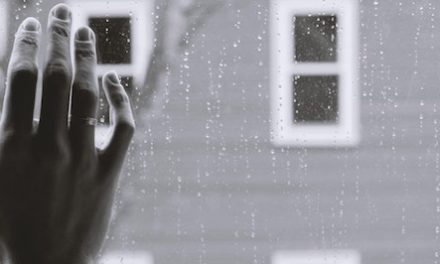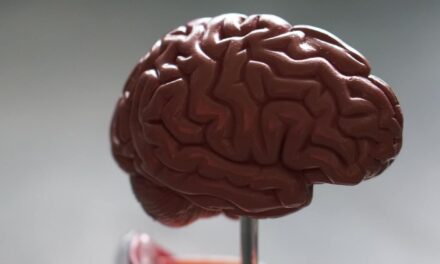Supervised by: Rita Kimijima-Dennemeyer, BA (Hons). Rita recently graduated from the University of Oxford having read Psychology, Philosophy, and Linguistics. She has a particularly interest in clinical psychology, mental health policy, and the ethics of mental health treatment, and she intends to pursue a masters degree in this field.
Abstract
Studies suggest that one’s attention span may be influenced by numerous elements, including lifestyle factors such as sleep and social media. The objective of this essay is to demonstrate how the number of sleep hours impact sustained attention in adults via comparisons of sustained attention of adults with different sleep durations or patterns. The biological and cognitive factors behind the effects will be addressed. Moreover, this paper will also discuss the hours of sleep resulting in the optimal level of sustained attention, as well as potential adjustments one can make to ensure the maintenance of ideal and consistent levels of sustained attention throughout the day. This paper will focus on the cognitive and biological factors of sustained attention of adults, rather than the socioeconomic and cultural factors.
Introduction
Attention is a cognitive process where one actively concentrates and selectively processes certain information or stimuli, whilst excluding irrelevant or extraneous stimuli in the surrounding environment.
This process has sparked interest in philosophers for many centuries and has been studied in the field of cognitive science — specifically in areas of cognitive psychology and cognitive neuroscience — since the late nineteenth century. Additionally, the concept of attention has been acknowledged in other fields of human study, including biology and the engineering of modern technology (Apa.org, 2023).
However, in order to understand attention at a deeper level, psychologists have categorised attention into four main types: selective, divided, sustained, and executive. One of the most discussed types is sustained attention, also known as vigilance. This term refers to one’s ability to maintain focus for a prolonged period of time. It is known that the frequency of task-relevant events significantly influences sustained attention performance, with more frequent events leading to better performances. Additionally, performance can also be enhanced by increasing the complexity of the task and having short periods of rest. Sustained attention is crucial in most daily tasks and significantly impacts one’s academic outcomes, safety, social communication, and mental health (Esterman & Rothlein, 2019).
There are several different theories and models that researchers have used to explain how attention works. Top-down and bottom-up attention are examples of theoretical constructs that have been used to explain the different components of attention. Top-down attention is driven by knowledge-based mechanisms that enhance the contrast between signal and noise, and it produces bias towards relevant stimulus features (Lim & Dinges, 2008). Bottom-up attention refers to target detection that is driven by alerting features inherent to a stimulus (Lim & Dinges, 2008). Another model of attention was proposed by Sturm and colleagues, which focuses on a multicomponent nature of attention. In this model, intensity aspects of attention are more fundamental than the selection aspects of attention. The function of vigilance is distinct from that of the selective aspect of attention and vigilance is closely related to the ability to inhibit peripheral or distracting stimuli (Lim & Dinges, 2008). Posner and Perterson proposed a model of attention that includes three functional systems that depend on separate but interacting neural networks: vigilance, orienting, and executive function Posner & Peterson, 1990). The vigilance network prepares and maintains attention to high-priority stimuli. The vigilance system is also associated with the brain’s norepinephrine neurotransmitter system. There are two types of vigilance: tonic and phasic. Tonic attention involves lengthy and sustained attention. Phasic attention requires shifting into an alert state in response to an acute internal or external event (Cunningham et al., 2018).
Notably, many cognitive processes are relevant to sustained attention; the neural architecture of this cognitive faculty is highly distributed. Sustained attention is also affected by the push-pull relationship of the greater dorsal attention-default mode coupling, which is associated with more variable out-of-the-zone attention states. Studies have also shown that there is an increase in communication of stimulus information between attentional networks and the default mode network when motivation is involved (Esterman & Rothlein, 2018). Attention-related brain regions tend to activate more during out-of-the-zone periods. This potentially reflects an inefficient mode of information processing. Optimal periods are more negatively impacted by transcranial magnetic stimulation to dorsal attention regions. This indicates that optimal sustained attention is achieved through efficient recruitment of top-down control. Research has also found that attention fluctuates between periods of low variability, high accuracy, and small error-related periods and periods of higher variability, lower accuracy, and larger error-related adjustments (Esterman & Rothlein, 2018).
Studies show that suboptimal levels of arousal can account for different types of lapses in attention. Individual differences in sustained attention are associated with specific information-based visual processing strategies. However, research on sustained attention often fails to consider that performance fluctuates within an individual from moment to moment. These fluctuations have heterogeneous causes, each of which may impact the stream of task-directed information processing uniquely. With the importance and functioning of sustained attention being established, it is necessary to also understand how attention is affected by a very significant process: sleep.
Sleep is a complex process where physical, mental, and sensory activity is decreased. This state is an essential part of one’s survival, and it is crucial to a variety of neurocognitive functions, as it removes toxin build-up which accumulates when one is awake. It is universally agreed that, out of all the components of cognition, vigilance, or sustained attention, is most consistently and drastically affected by sleep deprivation. Sleep has a major influence on our sustained attention in multiple ways. The average and healthy amount of sleep is seven to nine hours for adults. However, in recent years, many individuals are getting less sleep due to long work hours, the availability of round-the-clock entertainment, and other activities (National Institute of Neurological Disorders and Stroke, 2023).
But why is sleep so important? Sleep deprivation has many effects on the body like enhancing the time-on-task effect, decreasing vigilance, and an overall slowing of reaction times. This can make it difficult to complete normal tasks like cooking, walking, or talking. Frontal increases in theta band activity and global increases in resting alpha power are both associated with being tired, but decreased beta activity is most strongly associated with changes in vigilant attention.
It is also essential to achieve adequate hours of sleep, as sleep helps the hippocampus in storing long-term memories. During sleep, the hippocampus and neocortex review, repeat and process the events from each day and determine which ones will be stored long-term. Even though many processes involved in creating memories occur when awake and in complete consciousness, lack of adequate sleeping hours limits the capacity of the brain to perform these functions with ease and efficiency and weakens the process of consolidating memory. According to Marks (2011), “the development of attention and the development of working memory are closely related. Significant gains on working memory tasks overlap in developmental timing with key periods for development of sustained attention, the posterior orienting system, and the anterior attention system.” In order to maintain efficient sustained attention on a task or activity while successfully achieving positive outcomes, our brain needs to manipulate and recall stored information as well as activate working memory. Therefore, it is absolutely necessary that adults receive adequate sleeping hours to maintain their focus and also develop their working and long-term memories.
Performance after sleep deprivation is both unpredictable and open to extremely high levels of interindividual variation (Lim & Dinges, 2008). In order to review the accuracy of this statement and also further study the effect of restricted or excess sleep on sustained attention of adults, we gathered information from meta-analyses about experiments using the Psychomotor Vigilance Task (PVT performance), Attentional Blink (AB performance) and listening ability tests. The participants in these experiments were tested after both normal sleeping hours and restricted sleeping hours. In all experiments, it was clearly noticeable that participants with restricted sleeping hours had a slower mean reaction time, and also had a greater sleepiness score. Additionally, Miller (2016) included “a control group of 10 people who were instructed to sleep ‘as usual,’ and a sleep-deprivation group of eight people who did not sleep for 24 hours. Then, the participants were asked to listen to two different stories at the same time, each played in a different ear. The stories had different narrators and content. While the stories played, the researchers measured the participants’ brain activity.” In order to study the difference between the enhanced and suppressed signals, the participants were asked to only focus on one of the 2 stories, but the sleep deprived group had more difficulty focusing on just one. These results suggest that lack of sleep impairs sustained attention performance, resulting in slower stimuli response time and “very inconsistent response speed” (Miller, 2016). Lastly, lack of sleep leads to responses slower than 500ms, which is also referred to as a lapse in attention (Miller, 2016).
Results
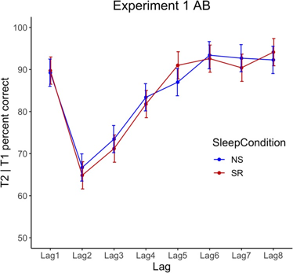
Figure 1.1: Performance in the Attentional Blink task, comparing those with normal sleep (NS) and those with restricted sleep (SR) (Shenfield et al., 2020)
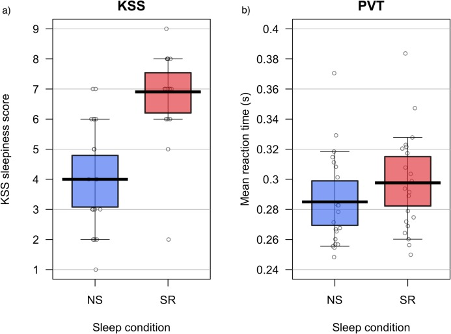
Figures 1.2 and 1.3: The effects of normal sleep (NS) and sleep restriction (SR) conditions on participant scores on the KSS sleepiness scale (Figure 1.2) and mean reaction times on the PVT task (Figure 1.3) (Shenfield et al., 2020).
We can infer that the differences in reaction times could be attributed solely to sleep, as none of the other variables were changed. In other words, the only independent variable was the sleeping hours and the dependent variable was the reaction time.
Additionally, loss of sleep intensifies the gradual deterioration of sustained attention throughout a cognitive task. This is known as the time-on-task effect. Sleep deprivation and night wakings increase the overall omission and commission errors (see figures 2.1 and 2.2). Reduced sleep for a single night can have significant effects on several mechanisms related to attention which in turn affects different aspects of cognition, depending on the person. Sleep deprivation results in an overall slowing of responses which increases the propensity of individuals to lapse for longer periods (>500 ms) and to make more errors of commission (Lim & Dinges, 2008). Most of the slow responses researchers have found either fall on the extreme end of a continuum, are perceptual processing, or are executive failures in the central nervous system. Subjects who have had at least eight hours in bed presented with virtually no lapses, while subjects who have had less than eight hours in bed presented with an increase in the percentage of lapses per test, and an increase in the average lapse duration (Lim & Dinges, 2008). This shows that while most people’s sustained attention is affected by their sleep levels after the first night, for some people sustained attention is more likely affected by their accumulated sleep debt.
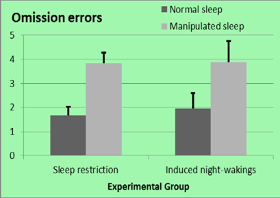
Figure 2.1: The effects of sleep restriction and induced night wakings in comparison to normal sleep on the number of omission errors made (Kahn et al., 2014)
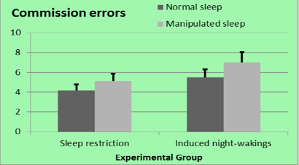
Figure 2.2: The effects of sleep restriction and induced night wakings in comparison to normal sleep on the number of commission errors made (Kahn et al., 2014)
While one in three adults obtain insufficient amounts of sleep, sleep deprivation affects everyone in different ways. Studies have shown that even severe sleep restrictions — three hours or less of sleep — do not always produce a significant impact on sustained attention after the first night (Kahn et al., 2014). Therefore it is not likely that an hour or two less of sleep would result in significant effects on attention. After the first night of reduced sleep the body starts to feel the effects of sleep deprivation more, a phenomenon which has been explained by the sleep debt theory. The sleep debt theory posits that if a person who needs eight hours of sleep each night only gets six hours for three days then they have six hours of sleep debt. That sleep debt affects a person until they restore their debt. It is also worth noting that Kahn and colleagues (2014) found in their study that sleep restriction and induced night-wakings did not lead to significantly different performance on the online continuous performance test (Kahn et al., 2014) (see Figures 2.1 and 2.2).
In a study conducted by Cunninghan et al. (2018), researchers showed that sleep restriction primarily affects the processing speed on a task measuring vigilance (See figures 3.1, 3.2, and 3.3). The graphs show that subjects who were sleep-restricted reported higher levels of sleepiness, fatigue and confusion, and much slower reaction times. Cunningham et al. (2018) studied thirty-nine healthy women (age 19 to 25 years old) during their mid-follicular phase of their menstrual cycle. The participants were asked to complete eight different tasks. There were nineteen women in the control group and twenty women in the sleep restricted group. This study found that one night of reduced sleep — consisting of three hours of sleep — impaired subjects’ performance on tasks assessing vigilance and other executive processes related to visual attention. This study provides similar findings to other studies we have looked at so far. It also shows that for sleep restriction to have a generalised impact across a group of people, it has to be quite severe — that is, a subject must sleep for four hours or less. As we have seen in previously discussed studies (e.g., Kahn et al., 2014), sleep deprivation or consistent night wakings do not always affect a group of subjects in the same way unless it is a severe restriction.
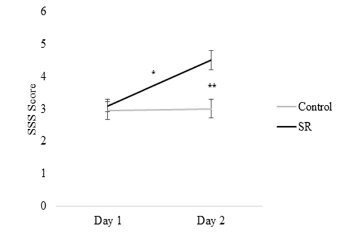
Figure 3.1: Sleepiness scores as reported by participants in the control and sleep restriction groups on Day 1 and Day 2 of the study, taken from Cunningham et al., 2018.
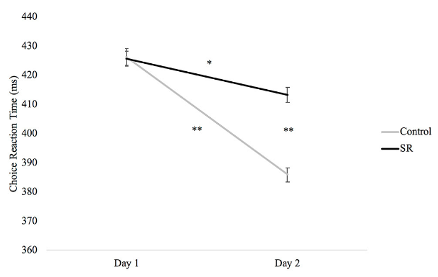
Figure 3.2: The effects of sleep restriction on performance in the Choice Reaction Time task, comparing the reaction times in control and sleep restriction groups on Days 1 and 2 (Cunningham et al., 2018).
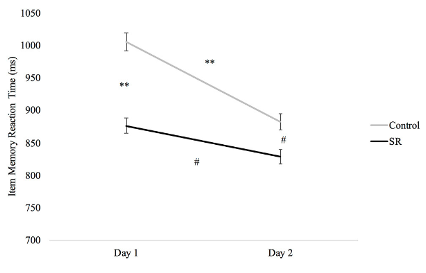
Figure 3.3: The effects of sleep restriction on reaction times in the Item Memory task, comparing control and sleep restriction groups on Days 1 and 2 (Cunningham et al., 2018).
Recent studies have also demonstrated that sleep extension is able to improve sustained attention and physical performance. For example, Rupp et al. (2009) reported that a week of sleep extension prior to a week of sleep restriction may decrease the rate of degradation in attention, alertness, and cognitive performance during periods of sleep restriction and recovery. This indicates that increasing total sleep time in a short period may be a viable countermeasure against the impairment of cognition and attention resulting from sleep deprivation.
In order to test the reliability of Rupp et al.’s results, Arnal et al. (2015) assessed the effects of 6 nights of sleep extension on sustained attention and sleep pressure before and during total sleep deprivation and on the subsequent recovery day. A total of 14 healthy adult male subjects (age range: 26–37 years) participated in two experimental conditions (randomised cross-over design): extended sleep (9.8 ± 0.1 h time in bed) and habitual sleep (8.2 ± 0.1 h time in bed). In each condition, subjects performed two consecutive phases, the first being 6 nights of either extended or habitual sleep, and the latter being three days in-laboratory where measurements were taken at baseline, total sleep deprivation and after 10 h of recovery sleep. The study took place in a residential sleep extension and sleep performance laboratory under continuous polysomnographic recording. The results of the experiment demonstrated that sleep extension improves Psychomotor Vigilance Task (PVT performance) as fewer lapses and faster speed are observed, as shown in the figures below.
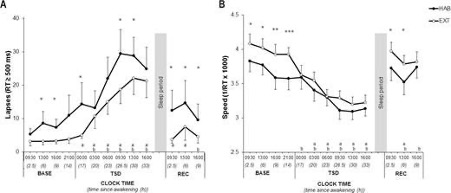
Figure 4: The effects of extended and habitual sleep on lapse rate (panel A) and reaction speeds (Panel B) during baseline (BASE), total sleep deprivation (TSD) and recovery (REC). Graphs taken from Arnal et al. (2015).
The study concluded that six nights of extended sleep reduces the impairment in sustained attention and alertness that results from sleep deprivation, and yields similar results to Rupp et al. (2009). This therefore reinforces the idea that extended sleep can act as a countermeasure against the side effects of sleep deprivation. This countermeasure may aid certain stakeholders, such as the military and healthcare workers, in managing challenging sleep schedules, and help maintain sustained attention and good performance.
However, excessive sleep, which usually occurs during the day, can lead to hypersomnia. Both insomnia and hypersomnia have been associated with a decrease in reaction time and memory processing. Additionally, other sleep-associated conditions, such as narcolepsy, also influence the body and brain in ways other than sustained attention. Narcolepsy is defined as “a chronic neurological disorder caused by an insufficient amount of the neurotransmitter orexin” (Newsom & Singh, 2023). Orexin, also referred to as hypocretin, is a form of neuropeptide produced by neurons in the hypothalamus. This neurotransmitter is essential for regulating arousal, wakefulness and sleep stability. The production of neuropeptides like orexin are directly linked to the consumption of macro and micromolecules and physical activity. Therefore, deprived or excessive sleeping patterns can be caused by irregular physical exercise or insufficiently balanced meals. In order to maintain effective and long-lasting sustained attention, improvements to lifestyle must be made to achieve regular and sufficient sleeping hours.
In fact, sleep and attention are more closely related than many individuals think. Both processes regulate a person’s awareness by suppressing incoming information from the environment (Kirszenblat & van Swinderen, 2015). Sleep is not a unitary process for all animals. In species such as unicellular animals (e.g., paramecia), animals without neurons (e.g., adult sponges), or in animals without a central nervous system (e.g., jellyfish), sleep does not occur (Kirszenblat & van Swinderen, 2015). There are also some species of animals who only “sleep” when they undergo physical development like malting. However, these species of animals do not sleep on a regular basis like humans and other organisms with complex nervous systems do. Sleep for these more complex organisms is not simply used to help with physical stress but is used to help support cognitive functions that are needed for everyday functioning.
Attention is a cognitive function which allows organisms to actively ignore certain stimuli, while maintaining focus on other stimuli. This is a process that also occurs when one is in a sleep state, as external sensory stimuli is ignored, while internally represented stimuli continue to be processed. Throughout the brain’s evolution it can be assumed that it is adapted to be able to support the extensive daily plasticity required for curating selective attention mechanisms, while simultaneously maintaining its more primitive functions (Kirszenblat & van Swinderen, 2015). We may deduce this because of how sleep and attention act as complementary states. They are both responsible for regulating one another. Sleep is crucial for maintaining optimal levels of attention and recent studies have shown that attentional demands also regulate sleep needs (Kirszenblat & van Swinderen, 2015). A person’s attentional level for that day will influence how much that person needs to sleep at night. This is another reason why a person’s sleep needs are specific to them, because if a person maintains a high attentional state for the whole day, then they will need extra sleep that night in order to replenish and organise their cognitive processes for the next day. If a person maintains a low attentional rate for the whole day, then they will not need as long of a sleep period that night because they did not exert their cognitive processes to their highest level.
Discussion
In this paper, we have examined how sleep affects sustained attention. Taking into account the fact that the average hours of sleep for adults ranges from six to eight hours, we have looked at studies that measured the performance of how sleeping less than the average hours can affect sustained attention. We have also looked at how sleeping more than the average hours can affect sustained attention negatively. Too much sleep or too little sleep was not as effective in helping people increase their ability to sustain attention in comparison to receiving an average amount of sleep. However, the quality of sleep was more impactful.
Sleep is a delicate and vital process. Too much sleep results in slower reaction times and slower cognitive processing. Too little sleep results in the body starting to deteriorate certain cognitive processes like sustained attention. This could be described as a Goldilocks dilemma. Based on the collective research conducted, sustained attention relies heavily upon a person’s quantity of sleep. In order for sustained attention to work at its highest level a person must be well-rested with no sleep debt to pay. From the study conducted by Lim and Dinges (2008), one can see that subjects who are sleep-deprived start slowing in their responses, which increases their lapse times.
Our findings were all found using previous articles and papers, as we were not able to conduct any experiments ourselves. This was a limitation at times. Our findings were left to those capable of conducting research. Thus, some of the studies that we used were relatively outdated. Since science is ever-changing, those past studies may be unreflective of current understanding of sleep and attention, and engagement with newer research may alter our understanding of this topic. However, the tests performed in these studies have been replicated in many other psychological studies and have been found to be reliable.
The purpose of this paper was to find the best way to utilise sleep, in order to optimise sustained attention. There are, however, many other studies that investigate the ways in which attention and other cognitive functions like memory or mood are affected by sleep. This paper not only focused on how attention is affected by sleep but it also highlights the important effect that an individual has on their sustained attention relation to sleep, because every person has unique sleep requirements in order to function at their highest cognitive level for the day.
Conclusion
Attention is not a single process but a collection of independent components that include voluntary and involuntary attentional processes (Lim & Dinges, 2008). Intensity and selective aspects of attention are what combine to produce controlled attention and the requirements are greater for a task that is not intrinsically engaging. Sleep loss affects cognitive processes and how our sustained attention is influenced and affected by it. Attention can be affected by the interaction of drives from multiple cortical and subcortical networks (Lim & Dinges, 2008). Harmful effects of sleep deprivation on attention appear to come from the interaction of the task environment and specific degradation in components of cognitive functions (Jackson et al., 2012). The research provided in our research paper has shown that sleep hours do have some impact on sustained attention. However, the quality of sleep is more important than the number of sleep hours individuals have when it comes to optimising sustained attention. The average hours of sleep changes as we age from childhood to our twilight years. What correlates most highly with sustained attention span is the quality of sleep instead. If one sleeps eight hours of distracted sleep filled with anxiety or restlessness, one may not perform at one’s best. If one sleeps a range of four to five hours, for example — which is less than the average hours of sleep for an adult — in a peaceful, sleep-friendly environment, one may wake up feeling energised, well-rested, and focused, with a high attention span.
Bibliography
Arnal, P. J., Sauvet, F., Leger, D., van Beers, P., Bayon, V., Bougard, C., Rabat, A., Millet, G. Y., & Chennaoui, M. (2015). Benefits of sleep extension on sustained attention and sleep pressure before and during total sleep deprivation and recovery. Sleep, 38(12), 1935–1943. https://doi.org/10.5665/sleep.5244
Cunningham, J. E., Jones, S. A., Eskes, G. A., & Rusak, B. (2018). Acute sleep restriction has differential effects on components of attention. Frontiers in Psychiatry, 9, 376159. https://doi.org/10.3389/fpsyt.2018.00499
Esterman, M., & Rothlein, D. (2019). Models of sustained attention. Current Opinion in Psychology, 29, 174-180. https://doi.org/10.1016/j.copsyc.2019.03.005
Jackson, M. L., Gunzelmann, G., Whitney, P., Hinson, J. M., Belenky, G., Rabat, A., & Van Dongen, H. P. (2013). Deconstructing and reconstructing cognitive performance in sleep deprivation. Sleep Medicine Reviews, 17(3), 215-225. https://doi.org/10.1016/j.smrv.2012.06.007
Kahn, M., Fridenson, S., Lerer, R., Bar-Haim, Y., & Sadeh, A. (2014). Effects of one night of induced night-wakings versus sleep restriction on sustained attention and mood: A pilot study. Sleep Medicine, 15(7), 825-832. https://doi.org/10.1016/j.sleep.2014.03.016
Kirszenblat, L. and van Swinderen, B. (2015). The yin and yang of sleep and attention. Trends in Neurosciences, 38(12), 776-786.
Lim, J., & Dinges, D. F. (2008). Sleep deprivation and vigilant attention. Annals of the New York Academy of Sciences, 1129(1), 305-322. https://doi.org/10.1196/annals.1417.002
Marks, H. (2011). Sleep deprivation and memory loss.WebMD https://www.webmd.com/sleep-disorders/sleep-deprivation-effects-on-memory#:~:text=Imaging%20and%20behavioral%20studies%20continue%20to%20show%20the,that%20it%20can%20be%20recalled%20in%20the%20future
Miller, S. G. (2016). How a sleepless night affects your ability to focus. Livescience.com https://www.livescience.com/54284-sleep-deprivation-selective-attention.html
National Institute of Neurological Disorders and Stroke. Brain Basics: Understanding Sleep. (2023). https://www.ninds.nih.gov/health-information/public-education/brain-basics/brain-basics-understanding-sleep
Posner, M. I., & Petersen, S. E. (1990). The attention system of the human brain. Annual review of neuroscience, 13, 25–42. https://doi.org/10.1146/annurev.ne.13.030190.000325
Reynolds, G. D., & Romano, A. C. (2016). The development of attention systems and working memory in infancy. Frontiers in Systems Neuroscience, 10. https://doi.org/10.3389/fnsys.2016.00015
Rupp, T. L., Wesensten, N. J., Bliese, P. D., & Balkin, T. J. (2009). Banking sleep: realisation of benefits during subsequent sleep restriction and recovery. Sleep, 32(3), 311–321. https://doi.org/10.1093/sleep/32.3.311
Shenfield, L., Beanland, V., Filtness, A. J., & Apthorp, D. (2020). The impact of sleep loss on sustained and transient attention: an EEG study. Peer J, 8, e8960–e8960. https://doi.org/10.7717/peerj.8960
Sleep Foundation (2020). Hypersomnia: causes, symptoms, and treatments. . Sleep Foundation. https://www.sleepfoundation.org/hypersomnia.


